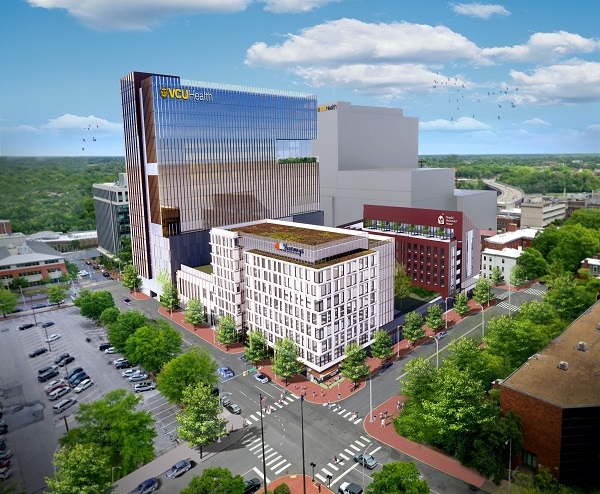
A rendering of the proposed office tower and complex that would replace the Public Safety Building. (Courtesy Capital City Partners)
Note: Due to a technical error, information received after deadline from Chief of Staff Lincoln Saunders was not added to the story correctly before it published. Saunders’ input is now included in the story.
Three months after Richmond City Council said “no” to the controversial Navy Hill project, the developers behind it are looking to revive a portion of the proposal with a mixed-use development that now calls for a taller VCU Health-anchored tower.
Capital City Partners, the development team that was enlisted for Navy Hill, has submitted an offer to the City of Richmond to buy the Public Safety Building property at 500 N. 10th St. and redevelop the site as a privately owned mixed-use office complex, highlighted with a 20-story tower that would exceed the height of the 17-story VCU Health outpatient building under construction across the street.
The $350 million project, totaling 545,000 square feet, is a variation of what was known as “Block D” in the Navy Hill project, but with the taller tower that would accommodate an additional 150,000 square feet of Class A office space. A tenant for that space isn’t named in the proposal, which describes the space as spec and “designed to attract new business to downtown Richmond.”
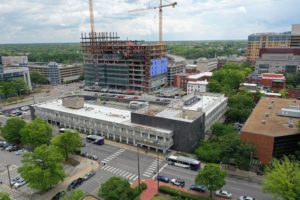
The Public Safety Building as viewed along Ninth Street, with the under-construction VCU Health outpatient building looming behind it. (Capital City Partners)
The rest of the tower, totaling 300,000 square feet, would house administrative and office space for VCU Health designed to support the Adult Outpatient Pavilion building under construction next door, as well as the health system’s nearby Children’s Hospital Pavilion.
An adjacent nine-story building would house new facilities for local nonprofit The Doorways, and a comparable-height building would house facilities for Ronald McDonald House Charities of Richmond. The smaller buildings also would house a new child development space for VCU Health.
The development also would include 20,000 square feet of ground-level retail space, including a pharmacy, and structured parking decks totaling 1,900 spaces, according to the proposal.
A letter to the city dated May 1 offers $3.175 million for the 3-acre site, which is bordered by Ninth, 10th and Leigh streets and the Department of Social Services building on East Marshall Street. The offer amount is based on an appraisal conducted by CBRE.
Property records show the latest city assessment valued the site at upwards of $15 million – about $4.32 million for the land and $11.05 million for the building.
Images submitted with the proposal show the tower and an adjacent nine-story building that would replace the 66-year-old Public Safety Building, which would be demolished. An extension of East Clay Street would cut through part of the property, connecting Ninth and 10th streets.
The project would not involve city funds or tax-increment financing, the funding mechanism that was one of several points of contention among council members and the public with the Navy Hill plan.
It also would return the property to the city’s tax rolls, producing $60 million in tax revenue over 20 years, according to estimates by CCP, which would own the buildings and pay for public infrastructure improvements, including the Clay Street extension.
CCP, led by Michael Hallmark of Richmond-based Future Cities and Susan Eastridge of Fairfax-based Concord Eastridge, was enlisted for Navy Hill by NH District Corp., a group of local business heavyweights led by Dominion Energy CEO Tom Farrell. The CCP proposal does not mention any involvement by NHDC.
Privately funded project
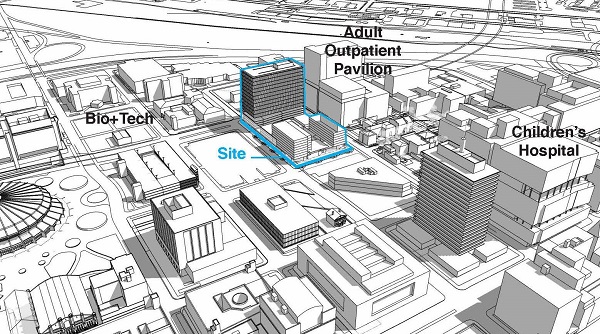
A graphic showing the site in relation to the outpatient building, VA Bio+Tech Park and other buildings. (Capital City Partners)
CCP plans to fund the project using a long-term lease from VCU Health as leverage. Financial terms of the lease would help underwrite project funding, which would be financed using what the proposal describes as “a credit-backed single tenant ‘build to suit/leaseback’ structure.”
CCP and VCU Health would negotiate final terms of the lease and financing with a financial institution of their choice, while the additional spec office space would be financed separately using a condominium structure.
The proposal also states that CCP has deposited $317,500, or 10 percent of its offered purchase price, in an escrow account as a “good faith deposit” coinciding with its proposal. The deposit was made with Thomas Title & Escrow, based in Dallas.
DPR Construction would be the contractor on the project, with Richmond-based SMBW signed on as the architect. VHB would handle site civil engineering and transportation planning, and Waterstreet Studio would handle streetscape and landscape design. Other firms on the project team include Richmond-based Sustainable Design Consulting and Chicago-based Omni Ecosystems.
CCP projects the development could be completed in late 2023.
The proposal includes letters of support from VCU Health, The Doorways, Ronald McDonald House Charities and Activation Capital, a nonprofit affiliated with the neighboring 34-acre VA Bio+Tech Park that is planning a six-story, 100,000-square-foot research building at 706 E. Leigh St.
That project adds to other investment in the area, including the Adult Outpatient Pavilion and, across Leigh Street from that building, VCU’s recently constructed School of Allied Health Professions building.
The projects dot the perimeter of the 10-block area beside the Richmond Coliseum that made up the Navy Hill proposal, which would have replaced the shuttered arena with a new facility envisioned to anchor the larger mixed-use development. The project, estimated to cost $1.5 billion and reliant in part on TIF funding, was voted down by City Council in February.
Another component of Navy Hill was a second office building that was set to house new offices for real estate research firm CoStar Group, which struck a tentative agreement to occupy a 400,000-square-foot structure that was planned beside the new arena.
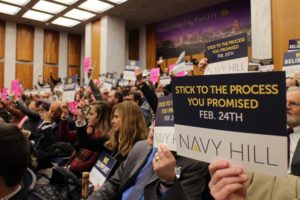
Attendees at a Navy Hill public hearing raised signs for and against the project ahead of council’s vote. (BizSense file)
Hallmark said CoStar is not involved in the new project and has not expressed interest in the 150,000 square feet of office space in the VCU Health tower. He said the tower was upped to 20 stories in height in part because of Navy Hill’s demise.
“Given that the other job-creating components of Navy Hill are not going forward, we felt it was important to create more economic development opportunity on this site, to take advantage of the tower base that we already planned,” Hallmark said in an email.
Asked if CCP hopes to revive other parts of Navy Hill or purchase other city-owned property in the area, Hallmark said no.
“We have a strong sense of loyalty to the major tenants planned for this site – The Doorways, Ronald McDonald House Charities of Richmond, expanding VCU Health Child Care and other VCU Health support space,” he said. “It is in everyone’s interest that their programs move forward with this project.”
Second offer received
In a memo this week to council members and Mayor Levar Stoney, acting Chief Administrative Officer Lenora Reid said the city’s economic development department is reviewing the CCP’s proposal and would correspond with the group on details. She said the proposal appeared to meet the city’s minimum requirements for consideration as an unsolicited offer.
“We will carefully review the offer and follow the process outlined by the city code for considering unsolicited offers,” said Stoney spokesman Jim Nolan in a statement. “The Department of Economic Development has communicated the receipt of the offer to council and will be discussing the contents with city council to decide next steps.”
CCP’s proposal follows another unsolicited offer the city received in February from D.C.-based Douglas Development Corp., which offered $15 million to buy nearly 15 acres of the Navy Hill project site, including the Coliseum, which it proposed to refurbish and bring up to current standards.
It wasn’t clear Wednesday where that offer stands. Lincoln Saunders, the mayor’s chief of staff, said the city sent a letter Feb. 24 acknowledging receipt and requesting more information but never heard back from Douglas.
Receipt of Douglas’s offer was also said to require, according to city code, that council solicit additional offers, either through an invitation for bids or a request for proposals, before it could respond to Douglas. Saunders said neither process had gone forward because the requested information was needed before council could officially consider the offer.

A rendering of the proposed office tower and complex that would replace the Public Safety Building. (Courtesy Capital City Partners)
Note: Due to a technical error, information received after deadline from Chief of Staff Lincoln Saunders was not added to the story correctly before it published. Saunders’ input is now included in the story.
Three months after Richmond City Council said “no” to the controversial Navy Hill project, the developers behind it are looking to revive a portion of the proposal with a mixed-use development that now calls for a taller VCU Health-anchored tower.
Capital City Partners, the development team that was enlisted for Navy Hill, has submitted an offer to the City of Richmond to buy the Public Safety Building property at 500 N. 10th St. and redevelop the site as a privately owned mixed-use office complex, highlighted with a 20-story tower that would exceed the height of the 17-story VCU Health outpatient building under construction across the street.
The $350 million project, totaling 545,000 square feet, is a variation of what was known as “Block D” in the Navy Hill project, but with the taller tower that would accommodate an additional 150,000 square feet of Class A office space. A tenant for that space isn’t named in the proposal, which describes the space as spec and “designed to attract new business to downtown Richmond.”

The Public Safety Building as viewed along Ninth Street, with the under-construction VCU Health outpatient building looming behind it. (Capital City Partners)
The rest of the tower, totaling 300,000 square feet, would house administrative and office space for VCU Health designed to support the Adult Outpatient Pavilion building under construction next door, as well as the health system’s nearby Children’s Hospital Pavilion.
An adjacent nine-story building would house new facilities for local nonprofit The Doorways, and a comparable-height building would house facilities for Ronald McDonald House Charities of Richmond. The smaller buildings also would house a new child development space for VCU Health.
The development also would include 20,000 square feet of ground-level retail space, including a pharmacy, and structured parking decks totaling 1,900 spaces, according to the proposal.
A letter to the city dated May 1 offers $3.175 million for the 3-acre site, which is bordered by Ninth, 10th and Leigh streets and the Department of Social Services building on East Marshall Street. The offer amount is based on an appraisal conducted by CBRE.
Property records show the latest city assessment valued the site at upwards of $15 million – about $4.32 million for the land and $11.05 million for the building.
Images submitted with the proposal show the tower and an adjacent nine-story building that would replace the 66-year-old Public Safety Building, which would be demolished. An extension of East Clay Street would cut through part of the property, connecting Ninth and 10th streets.
The project would not involve city funds or tax-increment financing, the funding mechanism that was one of several points of contention among council members and the public with the Navy Hill plan.
It also would return the property to the city’s tax rolls, producing $60 million in tax revenue over 20 years, according to estimates by CCP, which would own the buildings and pay for public infrastructure improvements, including the Clay Street extension.
CCP, led by Michael Hallmark of Richmond-based Future Cities and Susan Eastridge of Fairfax-based Concord Eastridge, was enlisted for Navy Hill by NH District Corp., a group of local business heavyweights led by Dominion Energy CEO Tom Farrell. The CCP proposal does not mention any involvement by NHDC.
Privately funded project

A graphic showing the site in relation to the outpatient building, VA Bio+Tech Park and other buildings. (Capital City Partners)
CCP plans to fund the project using a long-term lease from VCU Health as leverage. Financial terms of the lease would help underwrite project funding, which would be financed using what the proposal describes as “a credit-backed single tenant ‘build to suit/leaseback’ structure.”
CCP and VCU Health would negotiate final terms of the lease and financing with a financial institution of their choice, while the additional spec office space would be financed separately using a condominium structure.
The proposal also states that CCP has deposited $317,500, or 10 percent of its offered purchase price, in an escrow account as a “good faith deposit” coinciding with its proposal. The deposit was made with Thomas Title & Escrow, based in Dallas.
DPR Construction would be the contractor on the project, with Richmond-based SMBW signed on as the architect. VHB would handle site civil engineering and transportation planning, and Waterstreet Studio would handle streetscape and landscape design. Other firms on the project team include Richmond-based Sustainable Design Consulting and Chicago-based Omni Ecosystems.
CCP projects the development could be completed in late 2023.
The proposal includes letters of support from VCU Health, The Doorways, Ronald McDonald House Charities and Activation Capital, a nonprofit affiliated with the neighboring 34-acre VA Bio+Tech Park that is planning a six-story, 100,000-square-foot research building at 706 E. Leigh St.
That project adds to other investment in the area, including the Adult Outpatient Pavilion and, across Leigh Street from that building, VCU’s recently constructed School of Allied Health Professions building.
The projects dot the perimeter of the 10-block area beside the Richmond Coliseum that made up the Navy Hill proposal, which would have replaced the shuttered arena with a new facility envisioned to anchor the larger mixed-use development. The project, estimated to cost $1.5 billion and reliant in part on TIF funding, was voted down by City Council in February.
Another component of Navy Hill was a second office building that was set to house new offices for real estate research firm CoStar Group, which struck a tentative agreement to occupy a 400,000-square-foot structure that was planned beside the new arena.

Attendees at a Navy Hill public hearing raised signs for and against the project ahead of council’s vote. (BizSense file)
Hallmark said CoStar is not involved in the new project and has not expressed interest in the 150,000 square feet of office space in the VCU Health tower. He said the tower was upped to 20 stories in height in part because of Navy Hill’s demise.
“Given that the other job-creating components of Navy Hill are not going forward, we felt it was important to create more economic development opportunity on this site, to take advantage of the tower base that we already planned,” Hallmark said in an email.
Asked if CCP hopes to revive other parts of Navy Hill or purchase other city-owned property in the area, Hallmark said no.
“We have a strong sense of loyalty to the major tenants planned for this site – The Doorways, Ronald McDonald House Charities of Richmond, expanding VCU Health Child Care and other VCU Health support space,” he said. “It is in everyone’s interest that their programs move forward with this project.”
Second offer received
In a memo this week to council members and Mayor Levar Stoney, acting Chief Administrative Officer Lenora Reid said the city’s economic development department is reviewing the CCP’s proposal and would correspond with the group on details. She said the proposal appeared to meet the city’s minimum requirements for consideration as an unsolicited offer.
“We will carefully review the offer and follow the process outlined by the city code for considering unsolicited offers,” said Stoney spokesman Jim Nolan in a statement. “The Department of Economic Development has communicated the receipt of the offer to council and will be discussing the contents with city council to decide next steps.”
CCP’s proposal follows another unsolicited offer the city received in February from D.C.-based Douglas Development Corp., which offered $15 million to buy nearly 15 acres of the Navy Hill project site, including the Coliseum, which it proposed to refurbish and bring up to current standards.
It wasn’t clear Wednesday where that offer stands. Lincoln Saunders, the mayor’s chief of staff, said the city sent a letter Feb. 24 acknowledging receipt and requesting more information but never heard back from Douglas.
Receipt of Douglas’s offer was also said to require, according to city code, that council solicit additional offers, either through an invitation for bids or a request for proposals, before it could respond to Douglas. Saunders said neither process had gone forward because the requested information was needed before council could officially consider the offer.
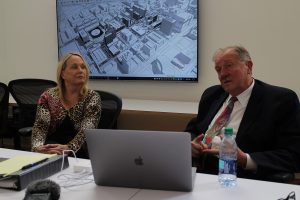
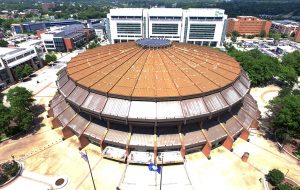
Well, would you consider adding downtown office space a bold move or a reckless on at this point?
Neither if they already have VCU as a tenant lined up.
This is a good deal for all concerned. In all probability the office tower would have Co-Star as the lead tenant, since they were in negotiations with regard to the Navy-Hill project.
Perhaps I’ve misread the article, Brian, but It seems clear that CoStar is not a player for the 170Ksf.
First broad brush sounds promising! Very exciting
The Public Safety Building is anything but safe. Replacing it is a much needed project.
This sounds like it could be a wonderful deal for downtown Richmond. It’s interesting that the Navy Hill folks stated emphatically that no one would ever be interested in developing this area if Navy Hill was defeated but now, only a few months after the proposal was apparently killed, they themselves are interested in the area. Will wonders never cease?
Wow must have $80 Million to put down on the construction loan. If this proposal makes it through there should be a stipulation that pledges the tax revenue be paid or excelerated no matter who the owner so VCU can’t buy it during construction and all of a sudden the developers sell it for a fortune and the building becomes tax exempt.
on the face of it, this looks good for the city.
This is a no-brainer. The City could use the $3M to remove the Coliseum for the next phase of development. It’s such an eyesore.
That’s a lot of material to be compacted in the hole that is now the arena. I wonder if leaving a “roof” over it would be a better plan until specifics are determined for the next use? It would be costly to fill to structural standards, then remove again if a future user needed the basement elevations.
Otherwise it will end up being a temporary water feature!
Need to start somewhere.
And, in ten or fifteen years we can get a replacement for the Coliseum – and we’re off to the races!
10-15? They have been talking about a replacement to the Diamond for almost 20 years…
Curious… how could the public safety building be assessed at $11 million? It’s a falling down rat trap that everyone wants to tear down. I’m wondering what the city’s assessment is based on.
Based on what is needed to keep the bond rating high most likely.
Several comments below about being “good for the city” seem to insinuate that this deal is, and the Navy Hill proposal was not. I suspected all along that the Navy Hill group after getting turned down would ultimately build the components that make financial sense. (IE the office, retail and multi tenant housing). I doubt in reality the Navy Hill group was ever expecting any profits from the arena and certainly not from the GRTC transfer station, the low income housing component and the revamp of the Blue’s Armory. For those that were against the sales tax district, that was… Read more »
I hope we are not talking about school needs not being addressed in 20 years but at least we will NOT be talking about having to increase the real estate tax rate or cuts to services thanks to bond payments on a failed Coliseum after 5 years.
1) The city doesn’t need an arena. It would be a HUGE money loser. If the private sector wants an arena without subsidy let them build it in Henrico. (Spoiler: They won’t) 2) The Blues Armory should be eligible for Historic tax credits you would think… 3) If was a false hood that a GRTC transfer center would be built by the Navy Hill group. All the Navy Hill proposal did was set aside land for a transfer center. It did not fund its construction. Additionally, the director of the GRTC said she wasn’t certain that GRTC needs a large… Read more »
I’m confused here. The images from Capital City partners shows new buildings between 10th & 11th streets, but the Google Maps polygon indicates the development will be a block over between 9th & 10th. as does the article which says ‘an extension of East Clay Street would cut through part of the property, connecting Ninth and 10th streets’. This would only be the case if the development was indeed on that latter block. The block from the images, across the street from the Adult Outpatient site, already has Clay Street running past it. Connecting Clay between 9th and 10th would… Read more »
Nevermind – was looking at this wrong…The Public Safety center I had thought was what the building demolished for Adult Outpatient had been called. Threw me off a block and the outdated imagery on Google Maps wasn’t helping.
CCP indicates that no city funds are required but then mention that the city will need to provide infrastructure upgrades such as the reconstruction of a block of Clay St. Raising street are to grade, intersections, traffic signals, street lights and trees – what is all of that going to cost – way more than the 3 million they will pay for the lot. In general, I am not opposed to this development but need to carefully vet what the city will be on the hook for. I like that it will be tax generating and that they have most… Read more »
CCP would be covering the costs of demolition and street restoration. The subject in this paragraph may be confusing but if the city was owning the buildings then it would not also be collecting taxes on them.
“It also would return the property to the city’s tax rolls, producing $60 million in tax revenue over 20 years, according to estimates by CCP, which would own the buildings and pay for public infrastructure improvements, including the Clay Street extension.”
A well defined private sector scope. The Parking Location is unclear. Lack of parking for this higher density will probably kill this deal in City Council’s eyes. Towers of parking decks around City Hall will not contribute to the new urbanism of walkable commercial streets or provide 5 stories residential above. Solve the City Public Housing and adjacent neighborhood impacted having assessment values one-quarter of other city neighborhoods before you further compact in the same old manner nearby downtown. Improving neighborhoods better impact the City tax base with desirable livable communities providing more tax assessment dollars for schools. The proposed… Read more »
Sufficient parking is always an important factor in new development. The article says parking decks (multiple decks?) with 1,900 spaces are part of this plan. Will someone who studies parking needs please assess if this number of spaces will be enough to serve the realistic needs of all new activity this development will create? Parking is already a real challenge in this area – we do not need to add to that. Thanks.
Looking at city requirements and based on the details in the article, the combined office, retail, and hospitality components would require around 1600 spaces.
There are also several underutilized parking decks in the area, now that the coliseum is shuttered, which are likely already serving the needs of The Doorways in addition to the GRTC transfer, nearby Pulse access, and the other adjacent massive parking deck under construction by MCV.
https://library.municode.com/va/richmond/codes/code_of_ordinances?nodeId=CH30ZO_ARTVIIOREPALORE